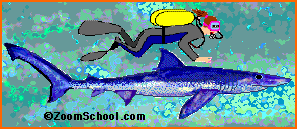|
|
|
GENERAL DESCRIPTION
Prionace glauca,
the blue shark, is a large, pelagic, indigo-colored shark. It is a sleek shark with long, pointed fins, a pointed snout, and
large eyes. Its sleek, tapered body makes it a graceful swimmer. Its elongated caudal fin (tail) provides swimming power as
the tail moves side-to-side.
SIZE
 Blue sharks grow to be up to 12.5 feet (3.8 m) long. Blue sharks grow to be up to 12.5 feet (3.8 m) long.
SWIMMING
The blue
shark's sleek, tapered body makes it a graceful swimmer. Its elongated caudal fin (tail) provides swimming power as the tail
moves side-to-side. These sharks are among the fastest swimming sharks and can even leap out of the water. They are also probably
among the fastest fish. Estimates of their speed varies; some say that they can swim at about 60 miles per hour (97 kph),
while more conservative estimates are about 22 mph (35 kph). There hasn't been enough experimentation on their speeds to have
an definitive answer.
TEETH
The teeth are pointed and serrated. This enables
the shark to catch slippery squid and fish, the mainstay of its diet.
Sharks' teeth are located in rows which rotate
into use as needed. The first two rows are used in obtaining prey; the other rows rotate into place as they are needed. As
teeth are lost, broken, or worn down, they are replaced by new teeth that rotate into place.
DIET
AND FEEDING HABITS
The blue shark's diet consists mostly of squid, but it will eat almost anything; it is an
opportunistic feeder.
HABITAT AND DISTRIBUTION
Blue sharks are pelagic; they are found in open waters. Like
most pelagic sharks, they are found worldwide.
BLUE SHARK ATTACKS
Blue
sharks are considered dangerous, and there have been attacks on people.
REPRODUCTION
Blue sharks are viviparous. Litters consist of 4 to 135 pups; the number of pups increases as the size of the mother increases. The gestation period
is almost 1 year. Females are mature at 5 years old.
MIGRATION
Atlantic blue sharks migrate across the Atlantic Ocean each year, following
the warm Gulf Stream waters on their eastward trip. They travel a circuit from the Caribbean Sea, along the coast of the USA,
east to Europe, south to the African coast, and back to the Caribbean.
SOCIAL GROUPS
Blue sharks often form large, all-male or all-female schools (groups)
which contain sharks that are about the same size. No one knowns why they do this.
POPULATION COUNT
The blue shark is classified as low risk/near endangered.
BLUE SHARK CLASSIFICATION
Kingdom Animalia (animals)
Phylum Chordata
SubPhylum
Vertebrata (vertebrates)
Class Chondrichthyes (cartilaginous fish)
Subclass
Elasmobranchii (sharks and rays)
Order Carcharhiniformes
Family Carcharhinidae
Genus Prionace
Species
glauca |
 |
BLUE SHARK PRINTOUT
Blue Shark Printout
|
 |
|
General Distribution:
Epipelagic, oceanic and circumglobal in warm seas worldwide; sometimes occurring near the coast where the shelf narrows or is cut by submarine canyons close to
shore. This is probably the most wide-ranging of all sharks, being found throughout tropical and temperate seas from 60ON to 50OS latitude. In the Pacific, it is present in greatest abundance
between 20ON and 50ON, where it shows strong fluctuations in
seasonal abundance related to population shifts northward in summer and southward in winter. There is considerable sexual
segregation in populations with females more abundant at higher latitudes than males.
Growth and Development:
Maximum reported size is 396 cm TL (~13 ft) but blue sharks taken off the U.S. West Coast average much smaller are seldom
over 260 cm TL or 8 ½ ft. For Pacific blue shark, size and age at 50% maturity in males is 203 cm TL or 6 ½ ft. and 4-5 years
old, and in females at 186 cm TL or 6 ft and 5-6 years old. Maximum age is estimated to be at least 20 years.
Feeding: In coastal waters
off the U.S. West Coast, blue sharks reportedly feed on anchovy, mackerel, hake, dogfish, squid and pelagic crustaceans including euphausiids. Elsewhere also known to feed also on small sharks and seabirds. May feed more
actively at night, with highest activity in the early evening.
Migrations, movements and stock structure:
In the North Pacific, seasonal migrations occur between latitudes 20ON and 50ON,
with northward movements extending into the Gulf of Alaska as waters warm during the summer months and southward movements
occurring during the winter months. In U.S. West Coast waters, mature females are thought to start their northward journey
in early spring as warm water moves northward, while juveniles of both sexes follow closely; large males start later and tend
to stay further offshore. Blue sharks tagged off southern California have been recaptured to the south off Baja California and Acapulco, Mexico; northward to off Oregon,
and westward to off the Hawaiian Islands and Midway in the central Pacific, indicating a wide ranging stock that may overlap
with the population fished by longliners in the central Pacific Ocean. The species is known to undertake extensive trans-oceanic
migrations in the Atlantic.
Reproduction: Viviparous;
bearing live young, fully formed. While in-utero the young are nourished by a yolk sac, then from the bloodstream by a maternal
placental connection. Litters average about 30, with maximum litter size reported at 135; gestation period is about 9-12 months.
Off California, parturition reportedly occurs in early spring, and mating occurs during late spring to early winter. The pattern
of young pups in the observed California-Oregon drift net catch suggest the nursery habitat may extend northward to off the
Columbia River mouth, and primarily offshore of the 100 fm isobath.
|
 |
|
|
 |
|
|
 |
|
|
 |
 |
|
|
|